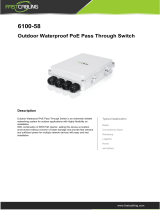
Chapter 1 About this document...................................................................... 5
Applicable products........................................................................................................................................5
Related publications.......................................................................................................................................5
Chapter 2 Introducing the switches............................................................... 6
Front of the switches......................................................................................................................................6
LED mode select button and indicator LEDs................................................................................... 9
Reset buttons.......................................................................................................................................9
Back of the switches.......................................................................................................................................9
Switch features............................................................................................................................................. 10
Chapter 3 Installing the switch......................................................................12
Shipping the switch in a rack...................................................................................................................... 12
Included parts............................................................................................................................................... 12
Installation procedures for 6100 switches................................................................................................ 14
Installation precautions and guidelines......................................................................................... 14
Prepare the installation site.............................................................................................................15
Verify that the switch boots correctly............................................................................................. 16
Disconnect power from the switch................................................................................................. 16
Mount the switch.............................................................................................................................. 16
Connect the switch to a power source........................................................................................... 24
(Optional) Install transceivers..........................................................................................................24
Connect network cables...................................................................................................................25
SFP Installation Notes.................................................................................................................................. 25
SFP+ installation notes.................................................................................................................................26
Chapter 4 Getting started with switch conguration..............................27
Recommended minimal conguration......................................................................................................27
Chapter 5 Troubleshooting............................................................................. 28
Basic troubleshooting tips...........................................................................................................................28
Diagnosing with the LEDs............................................................................................................................29
Proactive networking................................................................................................................................... 34
Hardware diagnostic tests...........................................................................................................................35
Testing the switch by resetting it.....................................................................................................35
Testing twisted-pair cabling............................................................................................................. 35
Testing switch-to-device network communications......................................................................36
Testing end-to-end network communications.............................................................................. 36
Restoring the factory default conguration..............................................................................................36
Downloading new switch software............................................................................................................ 36
Chapter 6 Specications..................................................................................37
Environmental specications......................................................................................................................37
Electrical........................................................................................................................................................ 38
Acoustics........................................................................................................................................................38
Contents
Contents 3





















